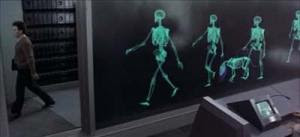The bill has been read twice by the Senate and is currently referred to the Senate Committee on Homeland Security and Governmental Affairs.
Lately, the government and media are certainly hyping up the domestic and homegrown terrorists as being the country's biggest threats. The bad guys are no longer allegedly in Afghanistan's caves. Instead, the media tells us the the violence may come from that guy in the next door office cubicle who's a loner, protests the government at rallies on the weekends and doesn't take the vaccines. This guy is a potentially bigger threat to America than Al-Qaeda - especially under this H.R. 1955, because he's a potential homegrown terrorist.
Violent radicalization? An extremist belief system? Facilitating ideologically based violence to advance political, religious or social change? What the h*ll do those terms mean? This bill's language appears to be quite specific, but it is actually quite vague and ambiguous. Anyone protesting anything related to the government could be considered a homegrown terrorist. If some type of domestic false flag happens in the next few weeks that can be pinned on the truth movement and infowarriors, you can bet that this bill will be passed with the quickness of the PATRIOT Act's passage.
Here's a summary of the bill:
SUMMARY AS OF:
October 23, 2007 -- Passed House amended.
Violent Radicalization and Homegrown Terrorism Prevention Act of 2007 - Amends the Homeland Security Act of 2002 to add a new section concerning the prevention of violent radicalization (an extremist belief system for facilitating ideologically based violence to advance political, religious, or social change) and homegrown terrorism (violence by a group or individual within the United States to coerce the U.S. government, the civilian population, or a segment thereof in furtherance of political or social objectives).
Establishes within the legislative branch the National Commission on the Prevention of Violent Radicalization and Homegrown Terrorism to: (1) examine and report on facts and causes of violent radicalization, homegrown terrorism, and ideologically based violence in the United States; and (2) build upon, bring together, and avoid unnecessary duplication of related work done by other entities toward such goal. Requires: (1) interim reports and a final report from the Commission to the President and Congress on its findings and recommendations; (2) the public availability of such reports; and (3) Commission termination 30 days after its final report.
Directs the Secretary of Homeland Security to establish or designate a university-based Center of Excellence for the Study of Violent Radicalization and Homegrown Terrorism in the United States to assist federal, state, local, and tribal homeland security officials, through training, education, and research, in preventing violent radicalization and homegrown terrorism in the United States. Requires the Secretary to: (1) conduct a survey of methodologies implemented by foreign nations to prevent violent radicalization and homegrown terrorism; and (2) report to Congress on lessons learned from survey results.
Prohibits Department of Homeland Security (DHS) efforts to prevent ideologically based violence and homegrown terrorism from violating the constitutional and civil rights or civil liberties of U.S. citizens or lawful permanent residents. Directs the: (1) Secretary to ensure that activities and operations are in compliance with DHS's commitment to racial neutrality; and (2) DHS Civil Rights and Civil Liberties Officer to develop and implement an auditing system to ensure that compliance does not violate the constitutional and civil rights or civil liberties of any racial, ethnic, or religious group, and to include audit results in its annual report to Congress.




A Princeton University research team, including (from left) undergraduate Elyse Powell, psychology professor Bart Hoebel, visiting research associate Nicole Avena and graduate student Miriam Bocarsly, has demonstrated that rats with access to high-fructose corn syrup -- a sweetener found in many popular sodas -- gain significantly more weight than those with access to water sweetened with table sugar, even when they consume the same number of calories. The work may have important implications for understanding obesity trends in the United States. (Photo: Denise Applewhite) Photos for news media